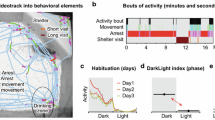Abstract
Systematic phenotyping of mouse strains and mutants generated through genome-wide mutagenesis programs promises to deliver a wealth of functional genetic information. To this end, the appropriation of a standard series of phenotyping protocols is desirable to produce data sets that are consistent within and across laboratories and across time. Standard phenotyping protocols such as EMPReSS (European Mouse Phenotyping Resource for Standardised Screens) provide a series of protocols aimed at phenotyping multiple body systems that could realistically be adopted and/or reproduced in any laboratory. This includes a series of neurologic and behavioral screens, bearing in mind that this class of phenotype is well represented in targeted mutants and mutagenesis screens. Having cross-validated screening batteries in a number of laboratories and in a number of commonly used inbred strains, our group was interested in establishing whether subtle changes in cage environment could affect behavioral test outcome. Aside from unavoidable quantitative differences in test outcome, we identified significant and distinct genotype-environment-test interactions. For example, specific strain order in open-field center entries and total distance traveled can be reversed depending on the form of enrichment used, while prepulse inhibition of the acoustic startle response is, even quantitatively, unaffected by the enrichment condition. Our findings argue that unless systematically recorded, behavioral studies conducted under subtle variations in cage environment may lead to data misinterpretation, although this could be limited to particular behaviors. Further investigations into the extent and limits of genetic and environmental variables are critical for the realization of both behavioral and functional genomics endpoints.




Similar content being viewed by others
References
Brown SD, Chambon P, de Angelis MH; Eumorphia Consortium (2005) EMPReSS: standardized phenotype screens for functional annotation of the mouse genome. Nat Genet 37, 1155
Chesler EJ, Wilson SG, Lariviere WR, Rodriguez-Zas SL, Mogil JS (2002) Influences of laboratory environment on behavior. Nat Neurosci 5, 1101–1102
Crabbe JC, Wahlsten D, Dudek BC (1999) Genetics of mouse behavior: interactions with laboratory environment. Science 284, 1670–1672
Irwin S (1968) Comprehensive observational assessment: Ia. A systematic quantitative procedure for assessing the behavioral and physiologic state of the mouse. Psychopharmacologia 13(3), 222–257
Izidio GS, Lopes DM, Spricigo L, Ramos A (2005) Common variations in the pretest environment influence genotypic comparisons in models of anxiety. Genes Brain Behav 4, 412–419
Jankowsky JL, Melnikova T, Fadale DJ, Xu GM, Slunt HH, et al. (2005) Environmental enrichment mitigates cognitive deficits in a mouse model of Alzheimer’s disease. J Neurosci 25, 5217–5224
Lazarov O, Robinson J, Tang YP, Hairston IS, Korade-Mirnics Z, et al. (2005) Environmental enrichment reduces Abeta levels and amyloid deposition in transgenic mice. Cell 120, 701–713
Morice E, Denis C, Giros B, Nosten-Bertrand M (2004) Phenotypic expression of the targeted null-mutation in the dopamine transporter gene varies as a function of the genetic background. Eur J Neurosci 20, 120–126
Van Loo PL, Blom HJ, Meijer MK, Baumans V (2005) Assessment of the use of two commercially available environmental enrichments by laboratory mice by preference testing. Lab Anim 39, 58–67
Wolfer DP, Litvin O, Morf S, Nitsch RM, Lipp HP, et al. (2004) Laboratory animal welfare: cage enrichment and mouse behavior. Nature 432, 821–822
Young KA, Berry ML, Mahaffey CL, Saionz JR, Hawes NL, et al. (2002) Fierce: a new mouse deletion of Nr2e1; violent behavior and ocular abnormalities are background-dependent. Behav Brain Res 132, 145–158
Acknowledgments
This work was funded by the MRC and by the EUMORPHIA project (QLG2-CT-2002-00930) which is supported by the European Commission under FP5.
Author information
Authors and Affiliations
Corresponding author
Rights and permissions
About this article
Cite this article
Tucci, V., Lad, H.V., Parker, A. et al. Gene-environment interactions differentially affect mouse strain behavioral parameters. Mamm Genome 17, 1113–1120 (2006). https://doi.org/10.1007/s00335-006-0075-x
Received:
Accepted:
Published:
Issue Date:
DOI: https://doi.org/10.1007/s00335-006-0075-x




